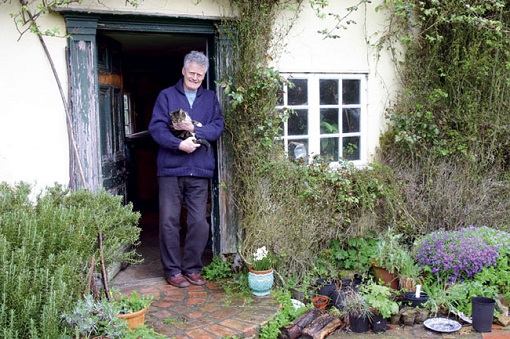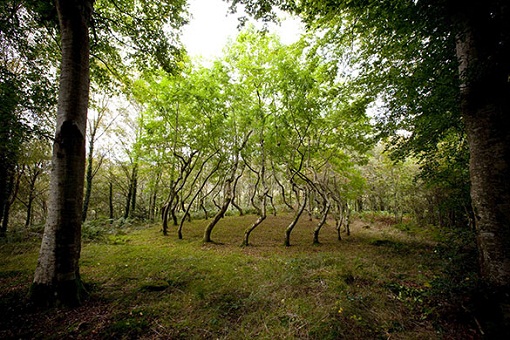From pubs in trees to childhood dens, Jonathan now concludes his arboreal notes with a treehouse for the old…
In my last post, I mused on the fierce comfort that children take from their tree houses and brooded on what these knocked together and wholly gratuitous structures could mean to us, the more-or-less middle aged (chiefly through this fine poem by Kathleen Jamie).
My final tree house is one for the later stages of life, and not only because it took its author some twenty years to create. Poignantly, the ‘ash dome’ or pleached bower erected by Roger Deakin in the grounds of his Suffolk farm has become a kind of memorial; by the time he came to describe it, in the closing pages of his Wildwood, Deakin was already terminally ill (although apparently unaware of this). In the book’s final sentence, he prophetically looks to a time “when the bower eventually comes of age, long after I am gone.”
As he proudly tells us, Deakin created his dome, a sort of natural folly or living sculpture, by planting a double row of ash trees, letting them grow to man’s height, and then grappling them together and grafting them each to each. The result of all this “wood-welding” – or ‘pleaching’ as it is properly known – is a sort of “composite pollard, or … laid hedge on stilts” in which the bent ashes have “the pent-up power of strongbows”.
Like the Sforza of Milan or Henry Hastings, the Dorset wodwo, Deakin was a maker of forest rooms. He designed his intimately welded ash hedge-on-stilts to be at least semi-habitable:
In the summer heat it is a cool, green room roofed with … the flickering shadows of ash leaves. I sometimes sling a hammock inside. I even installed a bed last year …
As described by Deakin, it is a refuge for all seasons:
The bower is floored in lords and ladies, ground ivy and mosses, and its eight trunks cross-gartered with wild hops, our English vines. They thatch its roof with their big cool leaves, dangling bunches of the aromatic, soporific female flowers from the green ceiling like grapes. As spring comes on, the bower fills like a bath with frothy white Queen Anne’s lace … Even at the age of twenty the trunks of the bower are beginning to show some of the early signs of what will accrue with age: they are green with algae and lichens are beginning to form around their damp feet. They are putting on ankle socks of moss. There is something goat-footed about ash trees: the shaggy signs of Pan.
If there is something uncanny about this creation, Deakin is also at pains to emphasize its solid practicality: it is, he assures us, “a remarkably stable structure, engineered in exactly the same way as a timber-framed house”. And indeed, there are clear continuities between Deakin’s ash den and the famously eccentric timber-framed house in which he chose to live for almost 40 years – described here by Robert Macfarlane, in a piece written shortly after the death of his friend:
Walnut Tree Farm … is made largely of wood. It is as close to a living thing as a building can be. When big easterlies blow, its timbers creak and groan “like a ship in a storm”, as Deakin put it … He kept the doors and the windows open, in order to let air and animals circulate. Leaves gusted in through one door and out of another. Swallows flew to and from their nest in the main chimney. It was a house which breathed. Spiders slung swags and trusses of silk in every corner. As I sat with Deakin, 10 days before his death, a brown cricket with long spindly antennae clicked along the edge of an old biscuit tin … Walnut Tree Farm was a settlement in three senses: a habitation, an agreement with the land, and a slow subsidence into intimacy with a chosen place.
Both house and bower rejoice in a blurring of indoors and out, a wholesale rejection of boundaries and thresholds. Nothing could be further from the modern hygenic attitude, as noted by Toby Ferris in the post that first set me off on these tree-house maunderings: “We return stray wildlife to the outside (wasps, small birds, flies if they’re lucky), and potter around with draught excluder and sealants, and set up systems of quarantine (doormats, porches, terraces) to manage the transition from one to the other.” Still more provocatively, perhaps, Deakin’s long, deep, burrowing habitation – his “settlement in three senses” – feels like a challenge to our phobia of ‘settling down’, as imagined in the Kathleen Jamie poem and endemic to the culture. Contrary to that favourite aphorism of Jonathan Meades, not only vegetables have roots.
So, etymologist of roots and graftings,
I fall back to my tree-house and would crouch
Where small buds shoot and flourish in the hush.
(Seamus Heaney, ‘The Boortree’)










Really lovely stuff Jonathan – and in Deakin’s words, where he talks of ‘…the bower eventually coming of age, long after I am gone.” I am reminded of a greek proverb –
A society grows great when old men plant trees whose shade they know they will never sit in
Great post Jonathan. I’d forgotten the description of Deakin’s house (from the Wild Places, I think) – in particular the settlement conceit, which is lovely.
You’ll have to forgive my quoting myself, but this is a description of a room I lived in Venice years ago, from the Anatomy of Norbiton (located here http://www.anatomyofnorbiton.org/other%20pages/on%20the%20places%20of%20Norbiton.php#myroom)
“When I lived in Venice my room overlooked a canal. Beyond the canal was a walled garden. Of necessity, because it was hot, I kept my window open most of the spring, summer and autumn, and there was a constant clockwork mechanism of flies picking out geometrical figures in the shady centre of the room; I also had mosquitoes rise up at night like an angry mob by torchlight; and an infestation on my window sill of woodlouse-type crustaceans, the Venetian name for which I have forgotten; and I once moved a bag on the floor and a two-inch scorpion crawled out from underneath.
I am not fond of creeping insects, have a terror of spiders, and cannot abide flies and mosquitoes. The only way I could maintain sanity in such a room was to think of it as an interface with the garden beyond the canal. It was neither interior space, nor exterior space. It was a bower or arbour. I had entered the world of these creatures, not the other way around. And so I learnt to love my room.”
All very well, but I trapped a colossal spider under a glass one day and threw him out of the window in a rainstorm (unforgivable cruelty), and I watched him struggle for a bit, then push himself up on the surface tension of the water, dodge the heavy rain drops,make it to the opposite side and make his way up the wall. It was a bionic performance, and I was convinced he was coming back for me. Think I’ll stick to the draught excluder.
Fabulous, Toby: that bit about mosquitoes ‘like an angry mob by torchlight’ is spot on for Italy.
I now live in a standard sort of new-build on a pretty standard edge-of-town estate but for 10 years we had a tiny timber-framed cottage that must have been something like Deakin’s farm. Absolutely soggy with atmosphere — but damp, draughty, lacking in basic modern amenities (central heating, reliable hot water), and open to all sorts of incursions from the natural world. These were not limited to the usual creepycrawlies. On one occasion — thinking about it now it seems like something out of Hitchcock or one of the big magical realist novels — two black birds exploded out of the fireplace and flapped heavily around the room. I suppose they must have fallen down the chimney. Gave my wife the screaming habdabs: as she was heavily pregnant at the time, and alone in the house, I suppose this could have had Consequences.
Crickey. Nature, eh? You can keep it.
Eric Hoffer:
“The truth about nature I found in the newspapers, in the almost daily reports of floods, tornados, blizzards, hurricanes, typhoons, hailstorms, sandstorms, earthquakes, avalanches, eruptions, inundations, pests, plagues, and famines. Sometimes when reading about nature’s terrible visitations and her massacre of the innocents it seemed to me that we are surrounded by devouring, pitiless forces, that the earth was full of anger, the sky dark with wrath, and that man had built the city as a refuge from a hostile, nonhuman cosmos. I realized that the contest between man and nature has been the central drama of the universe.”
Photos: Major flooding swamps Duluth [Minnesota], North Shore [Minnesota], [and Superior, Wisconsin]:
http://minnesota.publicradio.org/collections/special/columns/statewide/archive/2012/06/photos-duluth-north-shore-endures-major-flooding.shtml?refid=0:
Lovely stuff, Jonathan.
Great to see Roger Deakin appear. As well as that distinctive and fascinating sensibility, has there been a finer writer of prose in recent decades?